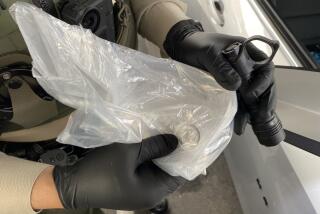A technology to help bring your bag home
If you flew in July, chances were greater this year than last that your bag didnât make the trip with you. Department of Transportation statistics showed that nearly eight of every 1,000 passengers in the U.S. arrived at their destination without the luggage they started with. That was up from about 6 1/2 passengers (and how we pity you half-passengers) the previous July.
But lost (or, more correctly, mishandled) luggage may one day be a thing of the past, thanks to an evolving technology. In the not-too-distant future, if your bag doesnât appear on the baggage carousel at LAX after a flight originating from McCarran International Airport in Las Vegas, you just might request that the airline have your bag text you and tell you where it is, sort of like when your child carries a cellphone.
Coming down the pike is the technology called RFID -- radio frequency identification. Using this technology, a passive radio transponder, which is slightly larger than a thumbnail, is embedded in a luggage tag thatâs put on your bag at check-in before your flight. The transponder in that tag is tuned to a unique frequency that can include both built-in code and some new information.
Antennas installed in RFID baggage areas are tuned to read your bag tag. The tags have a read/write function that allows airport personnel to update information on your bag tag, which helps track it if you get separated.
For now, RFID is being used at Hong Kong International Airport and McCarran, said Andrew Price, RFID project manager for the International Air Transport Assn. But other airports are looking at implementation.
San Francisco International uses RFID to track bags routed to the Transportation Security Administration for extra screening in its international terminal. Terminal 2 in Milan, Italy, has begun a non-trial RFID installation.
Between Amsterdamâs Schiphol and Parisâ Charles de Gaulle airports, Air France and KLM have a pilot RFID program that, they hope, will result in full implementation.
And for travelers who experienced baggage problems at Londonâs Heathrow this summer -- and there were many of them -- the good news is that the British Airports Authority is initiating an RFID trial at Heathrow International this fall. The bad news: British Airways, the carrier with the largest presence at Heathrow and a baggage record thatâs more than twice as bad as any major U.S. carrierâs, is not involved.
And thus far, LAX says it is not going to implement the technology -- at least not anytime soon.
But the transport association thinks more airports and airlines will adopt RFID to reduce baggage mishandling, especially as the technologyâs cost declines. In 1997, the cost of RFID was about $1.80 a bag; today, itâs about 15 cents.
For consumers, the implementation could mean considerably less baggage hassle. Nowadays, the destination tags that are wrapped around the handles of the bags contain a bar code. But the tags on 10% of the bags are misread, said Steve Lott, a spokesman for the International Air Transport Assn. âUsing RFID would go a long way to eliminate that read-rate problem we now have with bar codes,â Lott said.
McCarranâs RFID achieved 99% accuracy in its read rate, although a misread can occur if a tag slides under a bag handle.
With a bar code, if your luggage goes missing, someone has to look at each tag manually. With RFID, a baggage handler can tune a hand-held device to the frequency associated with your bag tag. When he nears your bag, the scanner goes off like a Geiger counter, signaling heâs hit the jackpot.
What happens if your bag is tagged at McCarran or Hong Kong but goes missing at a non-RFID airport? âRFID is useful at an individual airport [because] it enables a . . . track-and-trace system for the baggage,â Price of IATA said.
So if a bag goes missing at another airport that does not have RFID, it can still help, even if the other airport has no RFID system? Yes, although it does take a little brain power to deduce.
Consider a journey from Vegas through Philadelphia to Chicagoâs OâHare. âRFID used in Las Vegas means that we can be certain your bag left the airport,â he said. âMistakes are very seldom made at the final destination . . . so we can be fairly certain that the bag is still in Philly.â
And as technology progresses and cellphones become even more prevalent, your cellphone number may be part of the info thatâs entered on the tag. If you and your bag get separated, it can always text you to tell you where it is.
--
More to Read
Sign up for The Wild
Weâll help you find the best places to hike, bike and run, as well as the perfect silent spots for meditation and yoga.
You may occasionally receive promotional content from the Los Angeles Times.






